实验2 类和对象_基础编程1
实验任务一:

1 // 类T: 实现 2 // 普通函数实现 3 4 #include "t.h" 5 #include <iostream> 6 #include <string> 7 8 using std::cout; 9 using std::endl; 10 using std::string; 11 12 // static成员数据类外初始化 13 const std::string T::doc{"a simple class sample"}; 14 const int T::max_cnt = 999; 15 int T::cnt = 0; 16 17 18 // 对象方法 19 T::T(int x, int y): m1{x}, m2{y} { 20 ++cnt; 21 cout << "T constructor called.\n"; 22 } 23 24 T::T(const T &t): m1{t.m1}, m2{t.m2} { 25 ++cnt; 26 cout << "T copy constructor called.\n"; 27 } 28 29 T::T(T &&t): m1{t.m1}, m2{t.m2} { 30 ++cnt; 31 cout << "T move constructor called.\n"; 32 } 33 34 T::~T() { 35 --cnt; 36 cout << "T destructor called.\n"; 37 } 38 39 void T::adjust(int ratio) { 40 m1 *= ratio; 41 m2 *= ratio; 42 } 43 44 void T::display() const { 45 cout << "(" << m1 << ", " << m2 << ")" ; 46 } 47 48 // 类方法 49 int T::get_cnt() { 50 return cnt; 51 } 52 53 // 友元 54 void func() { 55 T t5(42); 56 t5.m2 = 2049; 57 cout << "t5 = "; t5.display(); cout << endl; 58 }

1 #pragma once 2 3 #include <string> 4 5 // 类T: 声明 6 class T { 7 // 对象属性、方法 8 public: 9 T(int x = 0, int y = 0); // 普通构造函数 10 T(const T &t); // 复制构造函数 11 T(T &&t); // 移动构造函数 12 ~T(); // 析构函数 13 14 void adjust(int ratio); // 按系数成倍调整数据 15 void display() const; // 以(m1, m2)形式显示T类对象信息 16 17 private: 18 int m1, m2; 19 20 // 类属性、方法 21 public: 22 static int get_cnt(); // 显示当前T类对象总数 23 24 public: 25 static const std::string doc; // 类T的描述信息 26 static const int max_cnt; // 类T对象上限 27 28 private: 29 static int cnt; // 当前T类对象数目 30 31 // 类T友元函数声明 32 friend void func(); 33 }; 34 35 // 普通函数声明 36 void func();

1 #include "t.h" 2 #include <iostream> 3 4 using std::cout; 5 using std::endl; 6 7 void test(); 8 9 int main() { 10 test(); 11 cout << "\nmain: \n"; 12 cout << "T objects'current count: " << T::get_cnt() << endl; 13 } 14 15 void test() { 16 cout << "test class T: \n"; 17 cout << "T info: " << T::doc << endl; 18 cout << "T objects'max count: " << T::max_cnt << endl; 19 cout << "T objects'current count: " << T::get_cnt() << endl << endl; 20 21 22 T t1; 23 cout << "t1 = "; t1.display(); cout << endl; 24 25 T t2(3, 4); 26 cout << "t2 = "; t2.display(); cout << endl; 27 28 T t3(t2); 29 t3.adjust(2); 30 cout << "t3 = "; t3.display(); cout << endl; 31 32 T t4(std::move(t2)); 33 cout << "t3 = "; t4.display(); cout << endl; 34 35 cout << "T objects'current count: " << T::get_cnt() << endl; 36 37 func(); 38 }
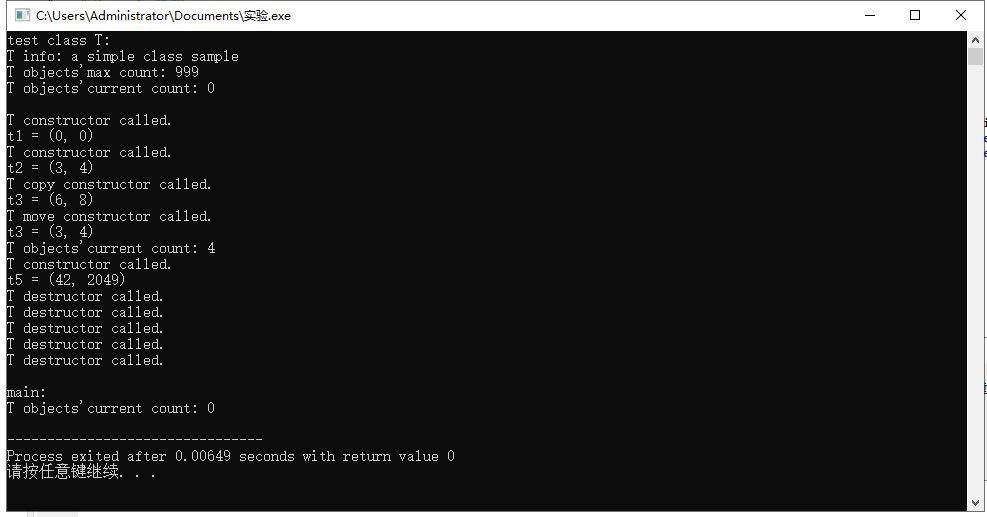
问题一:编译会失败

原因:如果去掉友元函数声明,编译会失败,因为func需要访问类的私有成员。
问题二:
功能:
1. 普通构造函数 T(int x = 0, int y = 0)**:这是该类的默认构造函数,用于初始化成员变量 m1 和 m2。当创建类 T 的实例时,如果没有提供具体的参数,系统将自动调用这个构造函数进行初始化。
2. 复制构造函数 T(const T &t)**:这个构造函数用于生成一个新对象,该对象是从另一个同类型对象复制而来的。它通过复制源对象的成员变量来设置新对象的状态。
3. 移动构造函数 T(T &&t)**:移动构造函数允许在不进行数据复制的情况下,将一个对象的资源转移到另一个对象。它接收一个右值引用作为参数。
4. 析构函数 ~T()**:析构函数用于执行清理工作,以释放对象所占用的资源。
调用时机:
普通构造函数在对象创建时被调用。
复制构造函数在通过已有对象创建新对象时被激活。
移动构造函数在将一个对象移动到另一个对象时被调用。
析构函数在对象生命周期结束时被调用,例如当对象超出作用域或被显式删除时。
问题三:
不能正常运行。
因为静态成员变量的定义和初始化应该在类定义之外,而不是在类定义内部。
实验任务2:

1 #ifndef COMPLEX_H 2 3 #define COMPLEX_H 4 5 6 7 #include <iostream> 8 9 #include <cmath> 10 11 12 13 class Complex { 14 15 public: 16 17 static const std::string doc; 18 19 20 21 22 23 Complex(); 24 25 Complex(double real); // 只指定实部 26 27 Complex(double real, double imag); // 指定实部和虚部 28 29 Complex(const Complex& other); 30 31 32 33 // 获取实部和虚部 34 35 double get_real() const; 36 37 double get_imag() const; 38 39 40 41 // 复数加法 42 43 void add(const Complex& other); 44 45 46 47 // 友元函数声明 48 49 friend Complex add(const Complex& c1, const Complex& c2); 50 51 friend bool is_equal(const Complex& c1, const Complex& c2); 52 53 friend bool is_not_equal(const Complex& c1, const Complex& c2); 54 55 friend void output(const Complex& c); 56 57 friend double abs(const Complex& c); 58 59 60 61 private: 62 63 double real; // 实部 64 65 double imag; // 虚部 66 67 }; 68 69 70 71 #endif // COMPLEX_H

#include "Complex.h" // 描述信息 const std::string Complex::doc = "a simplified complex class"; // 默认构造函数 Complex::Complex() : real(0), imag(0) {} // 只指定实部的构造函数 Complex::Complex(double real) : real(real), imag(0) {} // 指定实部和虚部的构造函数 Complex::Complex(double real, double imag) : real(real), imag(imag) {} // 拷贝构造函数 Complex::Complex(const Complex& other) : real(other.real), imag(other.imag) {} // 获取实部 double Complex::get_real() const { return real; } // 获取虚部 double Complex::get_imag() const { return imag; } // 复数加法 void Complex::add(const Complex& other) { real += other.real; imag += other.imag; } // 友元函数实现 Complex add(const Complex& c1, const Complex& c2) { return Complex(c1.real + c2.real, c1.imag + c2.imag); } bool is_equal(const Complex& c1, const Complex& c2) { return (c1.real == c2.real) && (c1.imag == c2.imag); } bool is_not_equal(const Complex& c1, const Complex& c2) { return !is_equal(c1, c2); } void output(const Complex& c) { std::cout << c.real << (c.imag >= 0 ? " + " : " - ") << std::abs(c.imag) << "i"; } double abs(const Complex& c) { return std::sqrt(c.real * c.real + c.imag * c.imag); }

1 #include <iostream> 2 3 #include "Complex.h" 4 5 6 7 using std::cout; 8 9 using std::endl; 10 11 using std::boolalpha; 12 13 14 15 void test() { 16 17 cout << "类成员测试: " << endl; 18 19 cout << Complex::doc << endl; 20 21 cout << endl; 22 23 24 25 cout << "Complex对象测试: " << endl; 26 27 Complex c1; 28 29 Complex c2(3, -4); 30 31 const Complex c3(3.5); 32 33 Complex c4(c3); 34 35 36 37 cout << "c1 = "; output(c1); cout << endl; 38 39 cout << "c2 = "; output(c2); cout << endl; 40 41 cout << "c3 = "; output(c3); cout << endl; 42 43 cout << "c4 = "; output(c4); cout << endl; 44 45 cout << "c4.real = " << c4.get_real() << ", c4.imag = " << c4.get_imag() << endl; 46 47 48 49 cout << endl; 50 51 cout << "复数运算测试: " << endl; 52 53 cout << "abs(c2) = " << abs(c2) << endl; 54 55 c1.add(c2); 56 57 cout << "c1 += c2, c1 = "; output(c1); cout << endl; 58 59 cout << boolalpha; 60 61 cout << "c1 == c2 : " << is_equal(c1, c2) << endl; 62 63 cout << "c1 != c3 : " << is_not_equal(c1, c3) << endl; 64 65 c4 = add(c2, c3); 66 67 cout << "c4 = c2 + c3, c4 = "; output(c4); cout << endl; 68 69 } 70 71 72 73 int main() { 74 75 test(); 76 77 return 0; 78 79 }
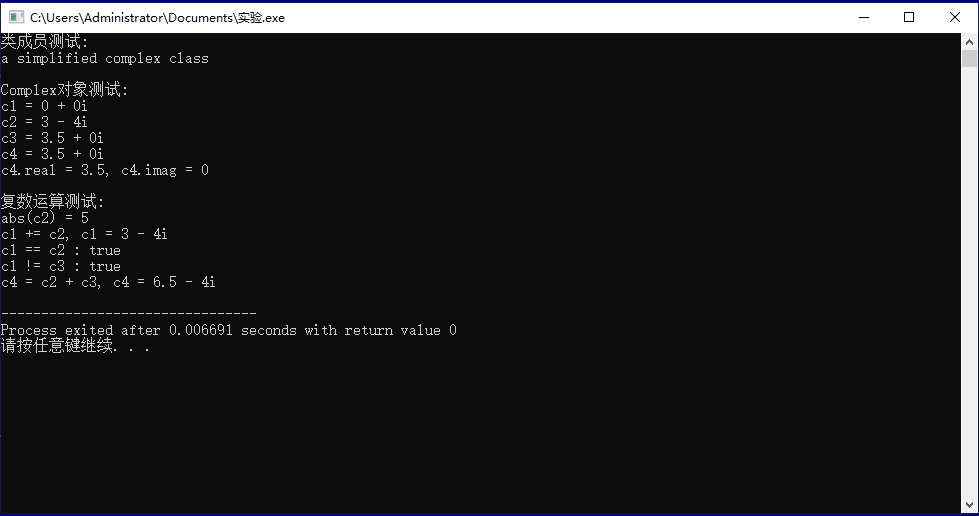
实验任务3:

1 #include <iostream> 2 #include <complex> 3 4 using std::cout; 5 using std::endl; 6 using std::boolalpha; 7 using std::complex; 8 9 void test() { 10 cout << "标准库模板类comple测试: " << endl; 11 complex<double> c1; 12 complex<double> c2(3, -4); 13 const complex<double> c3(3.5); 14 complex<double> c4(c3); 15 16 cout << "c1 = " << c1 << endl; 17 cout << "c2 = " << c2 << endl; 18 cout << "c3 = " << c3 << endl; 19 cout << "c4 = " << c4 << endl; 20 cout << "c4.real = " << c4.real() << ", c4.imag = " << c4.imag() << endl; 21 cout << endl; 22 23 cout << "复数运算测试: " << endl; 24 cout << "abs(c2) = " << abs(c2) << endl; 25 c1 += c2; 26 cout << "c1 += c2, c1 = " << c1 << endl; 27 cout << boolalpha; 28 cout << "c1 == c2 : " << (c1 == c2) << endl; 29 cout << "c1 != c3 : " << (c1 != c3) << endl; 30 c4 = c2 + c3; 31 cout << "c4 = c2 + c3, c4 = " << c4 << endl; 32 } 33 34 int main() { 35 test(); 36 }
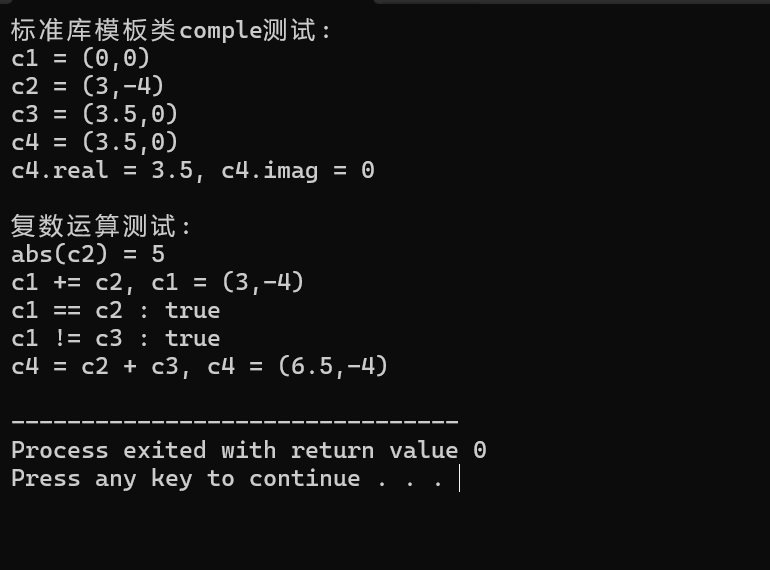
接口:
- `complex<double> c1` 使用默认构造函数创建了一个复数对象 c1。
- `complex<double> c2(3, -4)` 使用初始化列表构造一个复数对象 c2。
- `const complex<double> c3(3.5)` 创建一个常量复数对象 c3。
- `complex<double> c4(c3)` 利用复制构造函数生成复数对象 c4。
- 任务2:须手动定义多种构造函数以初始化复数对象。
- 任务3:可以直接使用列表初始化或特定构造函数来创建复数对象,代码更加简化。
- 任务2:需要手动实现加、减、乘、除等运算符的重载。
- 任务3:标准库的 complex 类已重载基本运算符,使复数运算更加直接。
- 任务2:必须通过成员函数(如 get_real() 和 get_imag())获取实部和虚部。
- 任务3:可以直接使用 `.real()` 和 `.imag()` 成员方法来访问复数的实部和虚部,代码看起来更清晰。
- 任务2:需要自定义一个 output() 函数来格式化输出复数。
- 任务3:可以直接利用 `std::cout` 和 `<<` 运算符输出复数。
- 任务2:需手动实现复数的模运算。
- 任务3:可以直接调用标准库中的 `abs()` 函数来计算复数的模。
实验任务4:

1 #pragma once 2 #include <string> 3 4 class Fraction { 5 public: 6 Fraction(int up, int down = 1); 7 Fraction(const Fraction&); 8 9 int get_up() const; 10 int get_down() const; 11 Fraction negative() const; 12 int gcd()const; 13 friend Fraction add(const Fraction&, const Fraction&); 14 friend Fraction sub(const Fraction&, const Fraction&); 15 friend Fraction mul(const Fraction&, const Fraction&); 16 friend Fraction div(const Fraction&, const Fraction&); 17 friend void output(const Fraction&); 18 19 20 static const std::string doc; 21 22 private: 23 int up; 24 int down; 25 26 };

1 #include "Fraction.h" 2 #include <iostream> 3 #include<cmath> 4 const std::string Fraction::doc = "Fraction类v0.01版. 目前仅支持分数对象的构造、输出、加/减/乘/除运算"; 5 6 Fraction::Fraction(int up, int down) : up(up), down(down) {} 7 8 Fraction::Fraction(const Fraction & other) : up(other.up), down(other.down) {} 9 10 int Fraction::get_up() const { 11 int a = gcd(); 12 return up/a; 13 14 } 15 16 int Fraction::get_down() const { 17 int a = gcd(); 18 return down/a; 19 20 } 21 22 Fraction Fraction::negative() const { 23 return Fraction(-up, down); 24 25 } 26 27 Fraction add(const Fraction & f1, const Fraction & f2) { 28 return Fraction(f1.up * f2.down + f2.up * f1.down, f1.down * f2.down); 29 30 } 31 32 Fraction sub(const Fraction & f1, const Fraction & f2) { 33 return Fraction(f1.up * f2.down - f2.up * f1.down, f1.down * f2.down); 34 35 } 36 37 Fraction mul(const Fraction & f1, const Fraction & f2) { 38 return Fraction(f1.up * f2.up, f1.down * f2.down); 39 40 } 41 42 Fraction div(const Fraction & f1, const Fraction & f2) { 43 return Fraction(f1.up * f2.down, f1.down * f2.up); 44 45 } 46 47 void output(const Fraction & f) { 48 int a = f.down, b = f.up; 49 int c = a, d = b; 50 int temp; 51 while (d != 0) 52 { 53 temp = c % d; 54 c = d; 55 d = temp; 56 } 57 int gcd = c; 58 b /= gcd; 59 a /= gcd; 60 if (a == 0) 61 { 62 std::cout << "分母不能为0"; 63 return; 64 } 65 if (a < 0) { 66 b = -b; 67 a = -a; 68 69 } 70 if (b == 0) { 71 std::cout << "0"; 72 73 } 74 else if (a == 1) { 75 std::cout << b; 76 77 } 78 else { 79 std::cout << b << "/" << a; 80 81 } 82 83 } 84 int Fraction::gcd()const 85 { 86 int c = up; 87 int d = down; 88 int temp; 89 while (d != 0) 90 { 91 temp = c % d; 92 c = d; 93 d = temp; 94 } 95 return c; 96 }

1 #include "Fraction.h" 2 #include <iostream> 3 4 using std::cout; 5 using std::endl; 6 7 8 void test1() { 9 cout << "Fraction类测试: " << endl; 10 cout << Fraction::doc << endl << endl; 11 12 Fraction f1(5); 13 Fraction f2(3, -4), f3(-18, 12); 14 Fraction f4(f3); 15 cout << "f1 = "; output(f1); cout << endl; 16 cout << "f2 = "; output(f2); cout << endl; 17 cout << "f3 = "; output(f3); cout << endl; 18 cout << "f4 = "; output(f4); cout << endl; 19 20 Fraction f5(f4.negative()); 21 cout << "f5 = "; output(f5); cout << endl; 22 cout << "f5.get_up() = " << f5.get_up() << ", f5.get_down() = " << f5.get_down()<< endl ; 23 24 cout << "f1 + f2 = "; output(add(f1, f2)); cout << endl; 25 cout << "f1 - f2 = "; output(sub(f1, f2)); cout << endl; 26 cout << "f1 * f2 = "; output(mul(f1, f2)); cout << endl; 27 cout << "f1 / f2 = "; output(div(f1, f2)); cout << endl; 28 cout << "f4 + f5 = "; output(add(f4, f5)); cout << endl; 29 } 30 31 void test2() { 32 Fraction f6(42, 55), f7(0, 3); 33 cout << "f6 = "; output(f6); cout << endl; 34 cout << "f7 = "; output(f7); cout << endl; 35 cout << "f6 / f7 = "; output(div(f6, f7)); cout << endl; 36 } 37 38 int main() { 39 cout << "测试1: Fraction类基础功能测试\n"; 40 test1(); 41 42 cout << "\n测试2: 分母为0测试: \n"; 43 test2(); 44 }
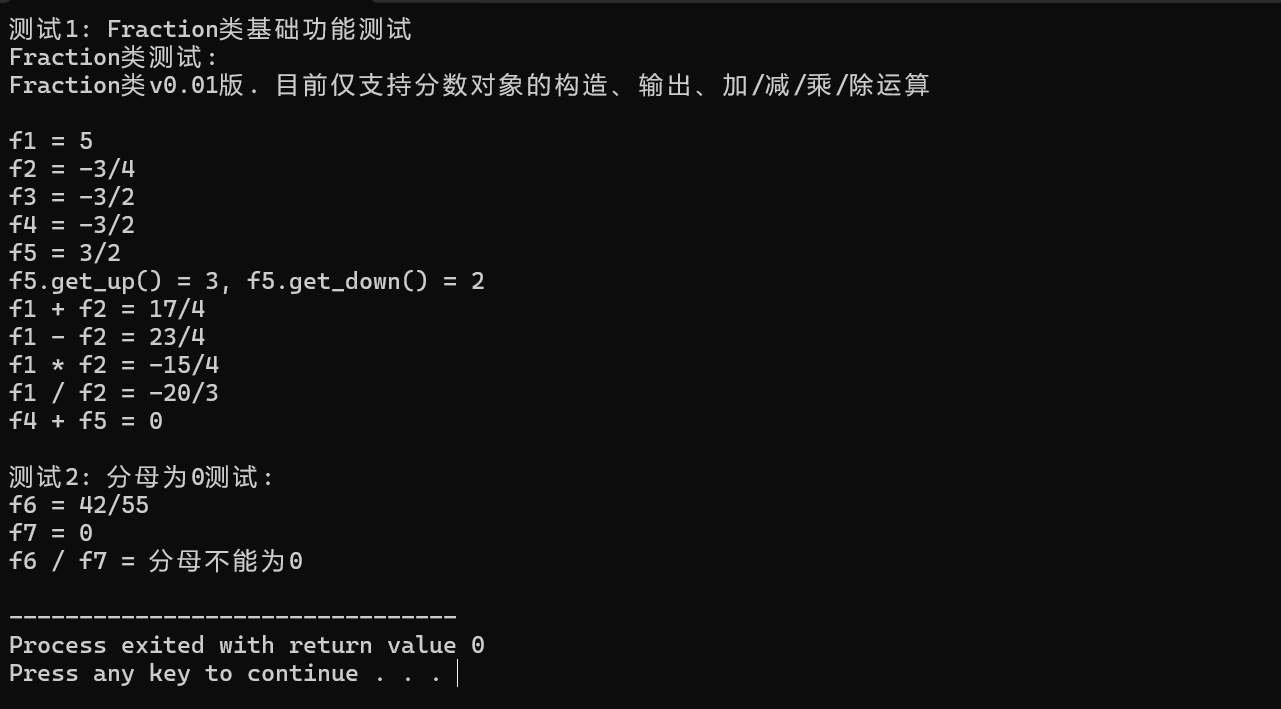
实验任务5:

#ifndef _ _ACCOUNT_H_ _ #define _ _ACCOUNT_H_ _ class SavingsAccount{ private: int id; double balance; double rate; int lastDate; double accumulation; static double total; void record(int date,double amount); double accumulate(int date)const{ return accumulation+balance*(date-lastDate); } public: SavingsAccount(int date,int id,double rate); int getId()const{return id;} double getBalance()const{return balance;} double getRate()const{return rate;} static double getTotal(){return total;} void deposit(int date,double amount); void withdraw(int date,double amount); void settle(int date); void show()const; }; #endif//_ _ACCOUNT_H_ _

1 #include"Account.h" 2 #include<cmath> 3 #include<iostream> 4 using namespace std; 5 double SavingsAccount::total=0; 6 SavingsAccount::SavingsAccount(int date,int id,double rate) 7 :id(id),balance(0),rate(rate),lastDate(date),accumulation(0){ 8 cout<<date<<"\t#"<<id<<" is created"<<endl; 9 } 10 void SavingsAccount::record(int date,double amount){ 11 accumulation=accumulate(date); 12 lastDate=date; 13 amount=floor(amount*100+0.5)/100; 14 balance+=amount; 15 total+=amount; 16 cout<<date<<"\t#"<<id<<"\t"<<amount<<"\t"<<balance<<endl; 17 } 18 void SavingsAccount::deposit(int date,double amount){ 19 record(date,amount); 20 } 21 void SavingsAccount::withdraw(int date,double amount){ 22 if(amount>getBalance()) 23 cout<<"Error:not enough money"<<endl; 24 else 25 record(date,-amount); 26 } 27 void SavingsAccount::settle(int date){ 28 double interest=accumulate(date)*rate/365; 29 if(interest!=0) 30 record(date,interest); 31 accumulation=0; 32 } 33 void SavingsAccount::show()const{ 34 cout<<"#"<<id<<"\tBalance:"<<balance; 35 }

1 #include"Account.h" 2 #include<iostream> 3 using namespace std; 4 int main() 5 { 6 SavingsAccount sa0(1,21325302,0.015); 7 SavingsAccount sa1(1,58320212,0.015); 8 sa0.deposit(5,5000); 9 sa1.deposit(25,10000); 10 sa0.deposit(45,5500); 11 sa1.withdraw(60,4000); 12 sa0.settle(90); 13 sa1.settle(90); 14 sa0.show();cout<<endl; 15 sa1.show();cout<<endl; 16 cout<<"Total:"<< SavingsAccount::getTotal()<<endl; 17 return 0; 18 }
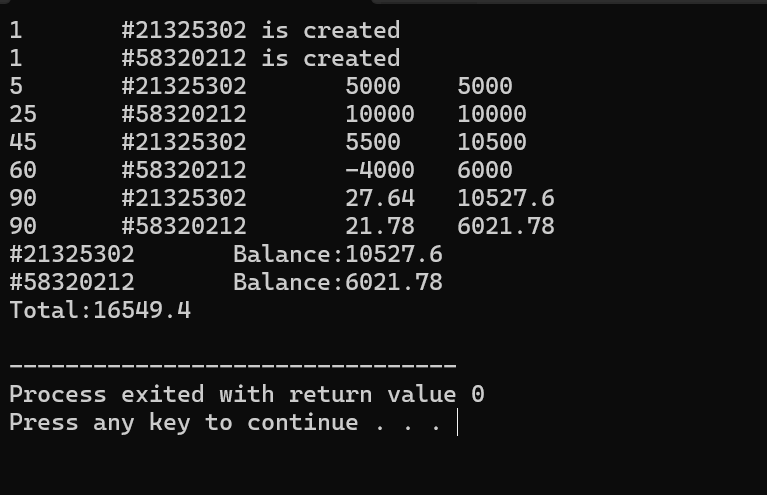
改进建议:
1. 可以将金额的四舍五入逻辑提取到一个独立的工具函数中,以提高代码的可重用性。
2. 考虑使用更具可读性的输出格式。例如,采用统一的格式来输出消息,可以增强信息的清晰度。
3. 增加一个专门的方法来获取当前余额,这样就不需要再调用显示方法。
4. 尽量为那些不改变类状态的方法加上 const 修饰符,例如 accumulate() 和 getBalance() 方法,因为它们不会产生副作用。
5. 如果引入了常量(例如每日利息计算),可以考虑将其定义为类中的常量。
1.在实现过程中,我发现自己在类设计时有时会忽略数据的保护机制,未来需要更加注重访问权限的设置。
2.对于复杂的类和功能,我意识到需要提前进行详细的设计和规划,以避免在实现过程中出现逻辑混乱。
3.在使用标准库时,我会更加关注其提供的功能,合理利用现有资源,提高开发效率。



 浙公网安备 33010602011771号
浙公网安备 33010602011771号